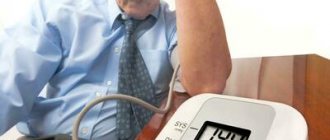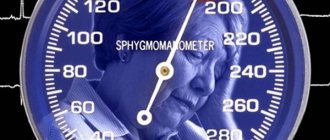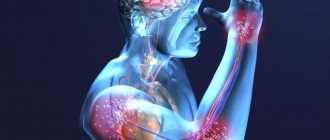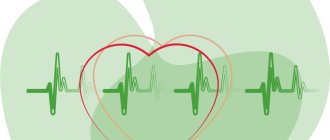04.12.2018
A.A.
(Last update: 07/10/2019)
There are contraindications. Specialist consultation required
Every year, complications of cardiovascular diseases claim the lives of tens of thousands of people. And acute situations caused by hypertension have the highest risk of mortality. Moreover, according to doctors, in most cases, death occurs as a result of incorrect or untimely medical care. Indeed, for many people, when a feeling of severe malaise occurs, it is common to self-medicate and wait until the problem resolves itself.
Therefore, it is important to act quickly and correctly in situations that pose a threat and to be able to recognize them. For example, if the pressure is 210 over 100, it is not enough to simply call an ambulance. Indeed, with such high blood pressure levels, even more dangerous complications may develop before the ambulance arrives. Therefore, everyone should understand what to do in order to provide the necessary assistance to a person facing a hypertensive crisis.
What does pressure 210 over 100 mean?
Ideally, a person's blood pressure should vary between 110-129/70-89. If the values on the tonometer are higher than the given indicators, then this condition is called hypertension. High blood pressure negatively affects the condition of internal organs, and the greater the deviation from the norm, the more pronounced the negative impact.
Do not self-medicate. Consult a specialist:
If the pressure is 210-100, then such indicators are considered very high. This indicates the development of a hypertensive crisis, or as it is also called “malignant hypertension.”
In such a crisis, all internal organs suffer greatly. After all, hypoxia develops in all tissues of the body. And this especially affects the heart, brain and kidneys.
You get promotional code OZON - 300 points for your first order. OZONAPIE1I (applied in the cart)
Moreover, the negative impact of this condition is so strong that it poses a serious danger. Therefore, in such a situation it is very important to act quickly.
It is worth noting that malignant hypertension has a number of characteristic features. Using them you can determine its presence with high accuracy.
Features of hypertensive crisis:
- Characterized by a sharp rise in pressure;
- Blood pressure is at very high levels;
- Severe symptoms of target organ damage are observed.
Interestingly, women are more at risk of developing a hypertensive crisis than men. Moreover, this problem has a tendency to recur.
A hypertensive crisis can last from an hour to five days. However, the duration of its course does not always depend on the quality of treatment.
Despite the danger of this condition, with proper and timely treatment, it is possible to stabilize the patient’s well-being and avoid the recurrence of such a situation and the development of dangerous complications. Effective control of GC has become possible thanks to the invention of a wide range of effective antihypertensive drugs.
Possible consequences
If treatment is not provided in a timely manner, it is ineffective or completely absent, then with a pressure of 210 over 100, serious complications and consequences may occur:
- The risk of aortic dissection increases, followed by a heart attack.
- Significant and very rapid deterioration of vision. Initially, sharpness disappears, after which there may be a complete loss of it, retinal detachment.
- Vascular diseases appear.
- The risk of hemorrhage increases.
- The kidneys begin to malfunction.
- Risk of stroke.
Even if you ignore a pressure of 210 per 100 once, serious consequences can occur. It is very important to take timely measures, preferably with the help of qualified doctors.
In addition to the described consequences, some other deviations are possible in different categories of people. Often, pressure 210 over 100 has a different manifestation pattern for different ages. This is an important factor that must be taken into account during examination and therapy.
Pressure surges are often observed during pregnancy, but in this position it should not be more than 140/90 mmHg. Art. if the indicators jump all the time, while the systolic value exceeds 150 mm Hg. Art., then there is an increased threat not only to the woman, but also to the fetus. Against the background of such a violation, placental abruption is possible, due to which the pregnancy is terminated.
In old age, blood pressure is always higher than the norm for a young person. But this does not mean that it can reach 210 per 100. This indicator indicates serious complications, tissue necrosis, heart attack, stroke and other troubles are possible.
How dangerous is a hypertensive crisis?
When a hypertensive crisis occurs, it is very important to promptly stabilize the patient’s condition. After all, it is a sharp jump in blood pressure without proper treatment that most often becomes the cause of complications that can lead to death.
Complications of hypertensive crisis:
- Heart attack;
- Thromboembolism;
Renal failure;- Paralysis;
- Stroke;
- Insufficient functioning of the heart;
- Paresis;
- Pulmonary edema;
- Rupture of aortic aneurysm;
- Brain swelling;
- Ischemia of the heart muscle;
- Angina pectoris.
You also need to understand that malignant hypertension has the most negative effect on internal organs. If the patient’s condition is not normalized as soon as possible, then there is a high probability of developing irreversible pathological changes in the heart, brain, lungs, blood vessels and kidneys.
It's not just the target organs that suffer from high blood pressure. Tissue hypoxia caused by this condition negatively affects the condition of the liver, joints, and organs of the endocrine system.
Thus, a hypertensive crisis provokes the development of pathological changes in absolutely all organs. Moreover, it often causes life-threatening conditions.
What body signals indicate the development of a crisis?
Since a hypertensive crisis is often a precursor to life-threatening conditions, it is very important to promptly recognize a surge in pressure and take appropriate measures.
Symptoms of a hypertensive crisis:
- Very severe headache. In this case, this sensation is usually localized in the occipital part of the head and has a pressing, increasing character. You may also feel a pulsating sensation in your temples.
- Often the patient experiences a strong feeling of nausea. In this case, vomiting does not bring relief.
- Redness of the face and neck. The redness may be patchy.
- Severe weakness. The patient literally falls off his feet. Loss of consciousness is possible.
- Blurred vision. This may cause spots and dots in front of the eyes, or temporary loss of vision.
- Vibrations of the eyeball. At very high pressure, this organ may twitch in any direction or pulsate. There may even be damage to small blood vessels in the eyes.
- Fever. During a hypertensive crisis, slight tremors are often observed throughout the body. Tremor of the limbs is especially pronounced.
- Lack of oxygen. Shortness of breath occurs. There may also be difficulty breathing.
- Hyperhidrosis. During a hypertensive crisis, increased secretion of sticky cold fluid is often observed.
- Heartbeat irregularities. The bullet can be both faster and slower.
- Ringing, knocking and other extraneous sounds in the hearing organs.
- Pressing and painful sensations in the chest area.
- Increased emotional excitability. Feeling of panic.
If such sensations occur, a hypertensive crisis can be suspected. However, to avoid mistakes, you need to measure the pressure with a tonometer.
At the same time, you need to understand that malignant hypertension can be indicated not only by indicators of 200 over 100. This condition can also develop in some people with blood pressure of 150 over 100.
Types of malignant hypertension
A hypertensive crisis is a concept that means a sharp rise in blood pressure to high levels. However, you need to understand that there are several types of this condition. And depending on this, prognosis and treatment are made.
First of all, GCs are divided according to the type of its development. In this case, it is taken into account whether the patient’s upper or lower pressure “jumped.”
Types of hypertensive crisis according to the type of development:
- Hyperkenetic. There is a pronounced increase in only systolic pressure. Usually this condition lasts for two to three hours. Complications in this case develop infrequently.
- Hypokenetic. Diastolic pressure rises to critical levels. A crisis of this type does not develop quickly, but can last up to several days. More often than not, the previous type causes dangerous complications.
- Eukinetic. Both systole and diastole indicators increase. The crisis develops very quickly, but does not last long.
Also, a hypertensive crisis is divided into types according to the degree of its danger. Ratner's classification identifies three variants of this condition.
Classification of severity of hypertensive type:
- Type 1 crisis. Typically, this condition lasts no more than an hour and is not accompanied by serious complications. With the right help, it is often possible to avoid negative changes in the body. This type of crisis is typical for hypertensive patients of degrees 1 and 2.
- Type 2 crisis. Considered more dangerous. Indeed, during its course, there is a high probability of irreversible changes occurring. However, home remedies often fail to normalize blood pressure in this condition.
- Complicated crisis. In this case, life-threatening situations often develop. Without immediate hospitalization, the risk of death is high.
Sometimes a hypertensive crisis is divided into adrenaline and norepinephrine. However, such conditions can also be considered as a single pathology.
What is the difference between an adrenaline crisis and a norepinephrine crisis?
- An adrenaline crisis is usually characterized by a sharp jump in blood pressure and a short duration. In this case, the standard symptoms may be accompanied by intense thirst and tears in the skin on the lips, while the pulse will increase. In this condition, there is a sharp release of adrenaline. This type of malignant hypertension most often occurs in hypertensive patients with degrees 1 and 2 of the disease.
- Norepinephrine type. This type of malignant hypertension develops more slowly, but also lasts longer. The patient can remain in this condition for up to five days. This type of crisis is provoked by a sharp release of norepinephrine. In this case, the pulse is usually slow, and attacks of suffocation may occur. This situation often occurs with stage 3 hypertension.
Also, malignant hypertension can be divided into cerebral, cardiac or water-salt hypertension. These designations indicate which system is most affected by the crisis.
You need to understand that it is almost impossible to independently determine the type of hypertensive crisis. That is why such a pathological condition cannot be treated at home.
Why does a hypertensive crisis develop?
A hypertensive crisis cannot develop on its own. In most cases, it is caused either by internal pathology or by a pronounced influence of an external factor. In this case, it is often the combination of such influences that is to blame.
It is also worth noting that rarely does a hypertensive crisis develop in an absolutely healthy person. Typically, this condition occurs in people with hypertension.
Doctors believe that a hypertensive crisis is most likely to occur in people who do not follow the rules for treating existing hypertension.
Hypertension as a root cause
It is hypertensive patients who most often experience a hypertensive crisis. Moreover, such a dangerous condition can occur even in the first degree of this disease.
Hypertension can develop without concomitant diseases, in which case it is called primary. A number of pathologies that indirectly or directly affect the cardiovascular and hormonal systems lead to the occurrence of secondary hypertension.
Causes of hypertension:
- Obesity;
- Diabetes;
- Hyperthyroidism;
- Adrenal diseases;
- Kidney diseases;
- Some disorders of the endocrine system;
- Pathologies of bones and joints leading to pinched blood vessels;
- Atherosclerosis;
- Diseases of the heart muscle.
Moreover, even if the patient is treating hypertension, but ignores the diseases that caused it, the risk of a hypertensive crisis remains high. After all, most of the described pathologies contribute to a sharp and unexpected jump in pressure.
Thus, in order to avoid the occurrence of a hypertensive crisis, it is extremely important to promptly identify the development of chronic hypertension and find its cause . Then proper treatment will help minimize the risk of negative consequences of this condition.
Reasons for such high blood pressure
An increase in blood pressure readings of 210 to 120 refers to stage 3 hypertension. It cannot increase on its own; there must be a situation that provokes a dangerous condition. Changes in blood pressure are affected not only by the proper functionality of the cardiovascular system, but also by the work of the endocrine, nervous structures and kidneys. The causes affecting the condition of hypertension are described in the following list:
Enter your pressure
Move the sliders
120
on
80
- violations of the course of hypertension therapy;
- dysfunction of the spinal column;
- kidney pathologies;
- presence of prohibited foods in the diet;
- bad habits: alcohol and smoking;
- endocrine system disorders;
- excess weight;
- atherosclerosis;
- stress;
- late toxicosis;
- narrowing of arterial walls.
| Cause | Its definition |
| Changes in vascular tone | Confirmed by research: laboratory tests, cardiogram, ultrasound. |
| Kidneys | The pressure cannot be treated, you need to pay attention to the kidneys. |
| Hormonal surges | A blood test will show low potassium levels and muscle weakness. |
| Heart | Intercostal pulsation of blood vessels is felt, blood pressure readings in the arms and legs are different. |
| Injury | If you suspect a head or back injury, you should do an electroencephalogram. |
| Medicines | All medications are agreed with the doctor. |
What factors can cause a crisis to develop?
Often a hypertensive crisis is a consequence of the influence of external negative factors. However, the risk of its occurrence increases if they affect a person suffering from hypertension.
External causes of hypertensive crisis:
- Severe stress;
- Very high physical and intellectual stress;
- Eating excessive amounts of salty foods;
- Alcohol intoxication;
- Hormonal imbalances;
- Sudden changes in weather conditions;
- Acclimatization;
- Burns of large areas on the body;
- Taking certain medications without a doctor's permission;
- Abruptly stopping medications that cause withdrawal symptoms;
- Long stay in a stuffy and hot room;
- Severe vomiting.
Interestingly, a hypertensive crisis can occur not only in people with chronic high blood pressure, but also in those who suffer from diseases that contribute to the development of hypertension. For example, severe stress can cause a surge in blood pressure in a person with diabetes, and excessive physical activity can cause an increase in blood pressure in an obese person.
In some cases, a hypertensive crisis can occur in a person who does not suffer from the diseases described above. For example, this scenario is possible when a healthy individual receives a large number of burns. As a result, the body produces a large amount of adrenaline, which can lead to a strong and sudden jump in blood pressure.
You need to understand that the unexpected occurrence of malignant hypertension in healthy people is possible in extremely rare cases. Patients who suffer from constantly high blood pressure are most at risk of developing a crisis.
First aid
If a person’s blood pressure has risen sharply, then it is necessary to call an ambulance. Before the ambulance arrives, you need to provide first aid to the person:
- Give the person 1 tablet of Nitroglycerin under the tongue (it is recommended to keep this drug in the pharmacy just in case).
- Place the person on the bed in a semi-sitting position.
- If a person has a headache, give him some kind of antispasmodic. The best choice is paracetamol (this medicine does not affect the functioning of the cardiovascular system, so in case of high blood pressure it is completely safe).
- If a person panics, it is necessary to calm him down. This point is very important, because in case of stress, pressure can increase, which can lead to the development of a hypertensive crisis.
- Make a compress using bandages, dilute water with apple cider vinegar in a ratio of 1 to 1, soak the compress with the solution and apply it to your forehead. Please note that this method does not cure hypertension, but it will help the person calm down.
- Upon arrival of the ambulance, prepare all the necessary medical documents and give them to the doctor.
Medicines
After hospitalization, urgent drug therapy is prescribed. The following drugs are commonly used:
- ACE inhibitors (vasodilate) - Fosinopril, Monopril and others.
- Adrenergic blockers (normalize the functioning of the heart muscle) - Atenolol, Carvedilol and so on.
- Diuretics (remove excess fluid and salt from the body) - Furosemide, Clopamide and others.
- Additional medications may be prescribed to relieve symptoms. For example, in the case of a headache, antispasmodics are prescribed, in the case of anxiety, mild tranquilizers, and so on.
Once your blood pressure has stabilized, your doctor may prescribe one or more of these medications for lifelong use. Such medications should be taken in accordance with the doctor's plan (usually 2-3 times a day), and also in case of a sudden attack. Self-medication is contraindicated, as this can lead to the development of a crisis.
Complex therapy
Following some simple rules can reduce the symptoms of hypertension:
- Give up tobacco products, as they are the main factor that provokes a sharp increase in blood pressure.
- Limit your salt intake (no more than 5 g), since removing excess salt requires an acceleration of metabolism, which will lead to an increase in blood pressure.
- Switch to a healthy diet - give up sour and salty foods, eat at least 4 fruits a day, give up fried foods, optimize your calorie intake (no more than 2500 kilocalories per day for a standard level of exercise), and so on.
- Take daily walks lasting at least 3 hours (please note that in case of type 4 hypertension, sports are contraindicated).
How to act during a hypertensive crisis
As mentioned above, most deaths caused by complications of a hypertensive crisis could have been avoided if the patient had received competent medical care in a timely manner. Therefore, the first thing you need to do when you find 210 to 100 readings on the blood pressure monitor is to call an ambulance.
To prevent the situation from escalating before the brigade arrives, you need to provide first aid to the victim. However, it is very important to do it correctly.
First aid rules for hypertensive crisis:
- First of all, it is necessary to sit the patient in a reclining position. To do this, you need to place a pillow or any other support under his back that allows him to hold him in the desired position.
- Then it is necessary to ensure free access of oxygen to the room. All windows should be opened and tight clothing should be loosened or removed.
- It is very important to calm the victim. Panic will increase blood pressure. To calm the patient, you need to ask him to take several deep breaths and exhales, counting to ten. If this does not help, then you need to take a sedative.
- It is important that before the ambulance arrives, the patient is in one position, without making sudden movements or turns.
- It is necessary to warm up the victim's lower limbs. To do this, you can apply mustard plasters to them or place your feet in a bath at a temperature of 40 degrees. You can also wrap them in a warm blanket.
- On the contrary, you need to place a cooling compress on your head.
- It is also necessary to give the patient an antihypertensive drug in the dosage prescribed by the doctor. This can be done if the victim has not previously taken antihypertensive drugs.
Before the ambulance arrives, you need to measure your blood pressure every ten minutes and record the readings.
When providing assistance during a hypertensive crisis, people often make a number of mistakes. They can lead to worsening of the condition.
What not to do during a hypertensive crisis:
- Give the patient plenty of water to drink. This can provoke vomiting, which will cause an even greater increase in blood pressure.
- Take an antihypertensive drug in dosages exceeding the maximum allowable. This can contribute to the development of overdose, heart attack and stroke.
- Place the patient with his legs up. This situation will contribute to increased blood pressure.
- Try to normalize the condition with the help of folk remedies. This may distort the effects of the drugs that the emergency team will use.
Pathology or normal?
For a normal, healthy person, systolic pressure should not be more than 130; if the figure becomes higher, then the condition cannot be described as normal. In this case, the body or certain organs malfunction. This causes diseases of the vascular system and capillaries. Due to high blood pressure, tissues begin to be damaged in people due to lack of blood, as well as weak pressure of blood flow.
A pressure of 210 over 100 indicates a hypertensive crisis; such a failure leads to a number of complications. And in order to prevent a crisis from occurring, you need to know the rules on how to reduce blood pressure.
What drugs should be used
There are a number of drugs that are most often used for hypertensive crisis. Before using them, you should consult your doctor. This can be done during an emergency call.
What drugs are used for hypertensive crisis:
| Name of the medicine | Time of action | Method of administration | Important information |
| Nitroglycerine | The effect appears 5 minutes after administration and lasts 10 minutes | Intravenous drip 100-200 mcg per minute | The drug is also effective for infarction and insufficient cardiac function. |
| Nicardipine | Begins to act 5 minutes after use and lasts up to 15 hours (depending on time of administration) | Intravenous drip from 5 to 15 mg per hour | Cannot be taken by people with insufficient cardiac function and ischemia of the heart muscle |
| Enalaprilat | Effective 15 minutes after administration for 6 hours | Intravenous 1.25-5 mg | Effective for heart failure |
| Sodium nitroprusside | Instantly has an effect that lasts 3 minutes | Diluted in glucose, administered dropwise at 0.25-10 mcg per kilogram per hour | Quickly reduces blood pressure. When administered, constant monitoring of blood pressure is required. |
| Verapamil | It takes effect within a minute after application. The effect lasts for an hour. | 5-10 mg is administered intravenously | Cannot be used in patients taking beta blockers or in patients with poor cardiac function. |
| Labetalol | The action begins 5 minutes after administration and lasts up to 8 hours | Intravenous drip. 2-5 mg of the drug is administered at a rate of 0.1 mg per minute. | Cannot be used for heart failure |
| Esmolol | Starts working a minute after administration and continues for 20 minutes. | The first minute is administered intravenously from 250 to 500 mcg per kilogram per minute, and then within 4 minutes from 50 to 100 mcg per kilogram per minute | It is most often used for complications such as aortic aneurysm dissection, as well as postoperative GC. |
| Phentolamine | The action begins 1 minute after administration and lasts 10 minutes | Administered intramuscularly in amounts from 5 to 15 mg | Effective for withdrawal symptoms |
| Propranolol | The onset of action is 10 minutes after administration. Duration - 4 hours. | Intravenous drip at a rate of 0.1 mg per minute in an amount of 5 mg | Most often used for complications such as aortic aneurysm dissection |
| Clonidine | The action begins 5 minutes after administration and continues for 5 hours. | 0.5-1 ml is injected intramuscularly | Cannot be used for stroke |
| Furosemide | Effective 5 minutes after administration for 8 hours. | From 40 to 200 mg is administered intravenously | Prescribed for a crisis complicated by cardiac or renal failure |
You need to understand that these drugs have a pronounced and strong effect. Therefore, you should use them yourself only as a last resort and after consultation with a specialist. Otherwise, the patient's condition may worsen.
For first aid during a hypertensive crisis, it is better to use drugs in tablet form . This may be Captopril, Furosemide, Nifedipine, Clonidine, Amlodipine. It is important not to exceed the maximum doses specified in the instructions for use.
After the ambulance arrived
The ambulance team will try to stabilize the patient's condition. Next, a decision will be made about the need for hospitalization.
In this case, most likely, the patient (or the one who will provide first aid) will be asked several questions. To make the doctor’s work easier, it is better to prepare answers to them in advance.
What the ambulance officer will ask:
- Time when excessively high blood pressure was noticed;
- Symptoms that accompanied this situation;
- Results of pressure recording before the ambulance arrives;
- What working pressure is usually observed in the victim;
- Age of the victim;
- The presence of certain chronic diseases in the anamnesis;
- Do you have a history of hypertensive crisis and other dangerous complications;
- What medications does the patient take on a regular basis?
- What remedies were taken on the day the ambulance was called?
Features of the treatment of stage 3 hypertension
IT IS IMPORTANT TO KNOW!
STILL STRUGGLE WITH ARTERIAL HYPERTENSION INCORRECTLY? Reduces stress hormone levels and prevents oxygen starvation Read more »
If you repeatedly observe elevated blood pressure, but have not yet sought medical help, then with a pressure of 210/120 mm Hg. Art. It is necessary to visit a doctor to determine the cause of a hypertensive crisis and select effective treatment. The main goal of treating such high blood pressure is to lower it to reduce the likelihood of developing cardiovascular disease. Treatment of stage 3 hypertension consists of drug and non-drug therapy. To stabilize blood pressure and prevent complications, the doctor prescribes the following medications:
- diuretics;
- beta blockers;
- heart medications;
- calcium antagonists;
- antihypertensive drugs.
In the presence of secondary pathological conditions, drugs from other groups are selected. It should be borne in mind that medications for hypertension are selected individually, so you should not treat high blood pressure with pills recommended by your friends or family. An important part of treatment is changing lifestyle and eliminating predisposing factors. A person with a blood pressure of 210 over 120 must follow a special diet, lead an active lifestyle, and also stop drinking alcoholic beverages and smoking. To achieve a better result, folk remedies, physiotherapy, and spa treatment are recommended.
Prognosis for the treatment of hypertensive crisis
A hundred years ago, the life expectancy of patients who suffered a hypertensive crisis usually did not exceed 2-4 years. This was due to the lack of effective antihypertensive drugs and insufficient knowledge of hypertension.
At the moment, medicine has come a long way. Therefore, with timely and correct provision of medical care, the prognosis can be very favorable.
Prognosis for hypertensive crisis:
- In more than 70% of cases, after medical care the patient’s condition returns to normal. At the same time, the internal organs do not have time to suffer greatly from the transferred condition. With the right approach to further treatment, the victim will be able to live his normal life.
- In 15% of cases, it will not be possible to quickly normalize the condition. The patient is hospitalized. Excessively high blood pressure can negatively affect the condition of target organs and lead to irreversible changes in them. In this case, the patient will require long-term rehabilitation and serious treatment in a hospital.
- In 10% of cases, life-threatening complications accompany a hypertensive crisis. In this case, the patient requires resuscitation. This is followed by limited performance and long-term rehabilitation.
It should be understood that in any case, after a hypertensive crisis, a relapse may occur. Therefore, such patients need to be especially careful about treatment and their lifestyle.
Drug treatment
After stopping the hypertensive crisis and normalizing the pressure and general condition of the patient, doctors conduct a thorough diagnosis. It allows you to evaluate the internal organs. Based on the data obtained, doctors prescribe treatment, which includes the use of certain medications:
- Diuretics make it possible to control blood pressure and also reduce the risk of complications of the heart and blood vessels. It is recommended to use Indapamide.
- Calcium channel blockers, which allow better tolerance to physical activity, are more often prescribed to older people who have atherosclerotic disease or angina pectoris. Nifedipine and Verapamil are used for treatment.
- Beta-blockers, tablets, are used not only to normalize blood pressure, but also to eliminate pathology of the cardiovascular system. Recommended for use after a heart attack and for angina pectoris. Metoprolol and Bisoprolol are prescribed for therapy.
- ACE inhibitors are very effective drugs for hypertension, suitable for any category of people, and can extend the life of patients by several years. Doctors prescribe Enalopril, Captopril.
- Sartans are recommended for renal hypertension. Valsartan and Telmisartan are used for treatment.
For hypertension, medications are often combined, especially if the pressure is 210 over 110. Combining medications is carried out only by a doctor; combining medications on your own is strictly prohibited. In modern medicine, Clonidine is no longer used, although it can quickly help with a hypertensive crisis. This medication is very dangerous and can kill a person if the dosage is not followed.








